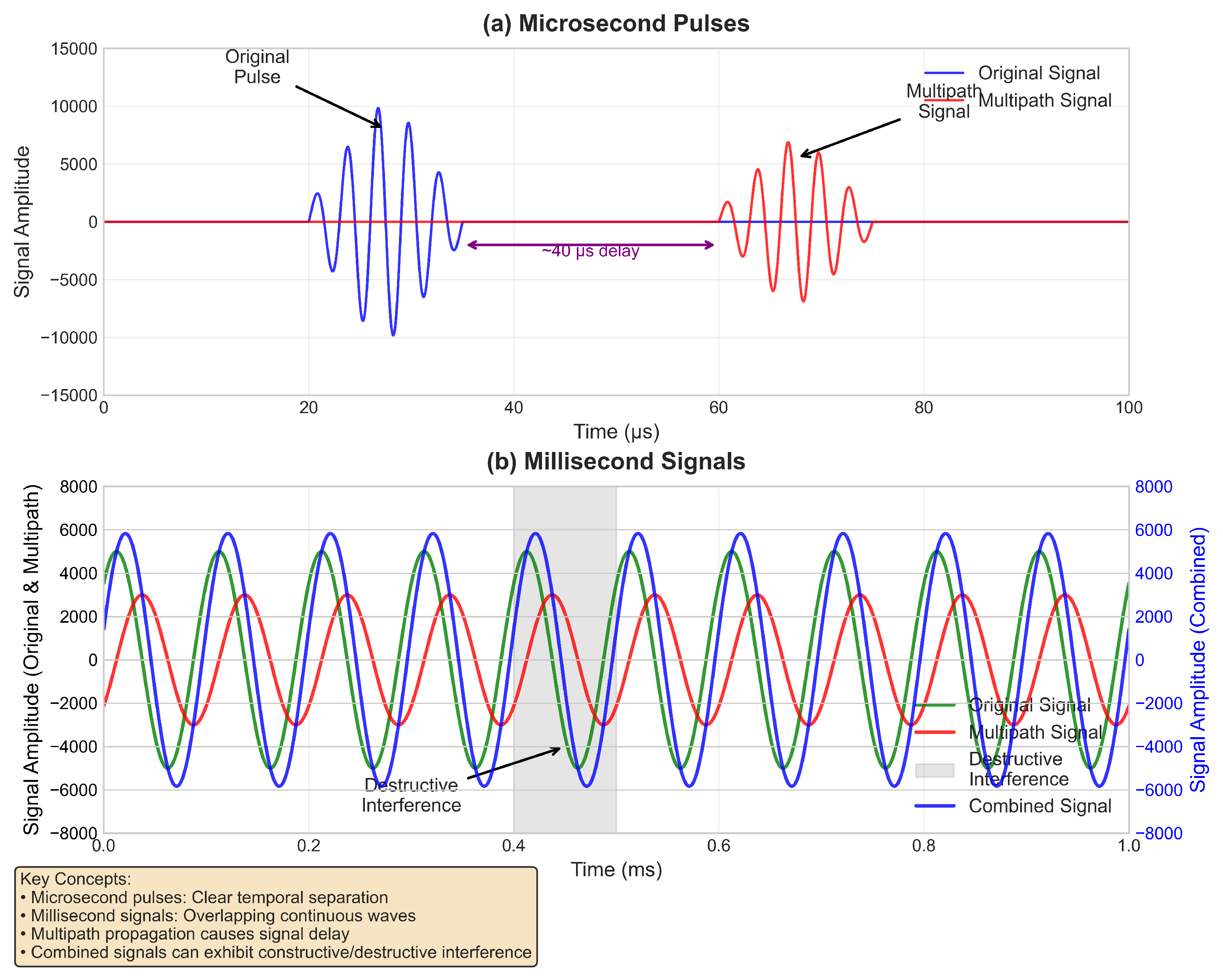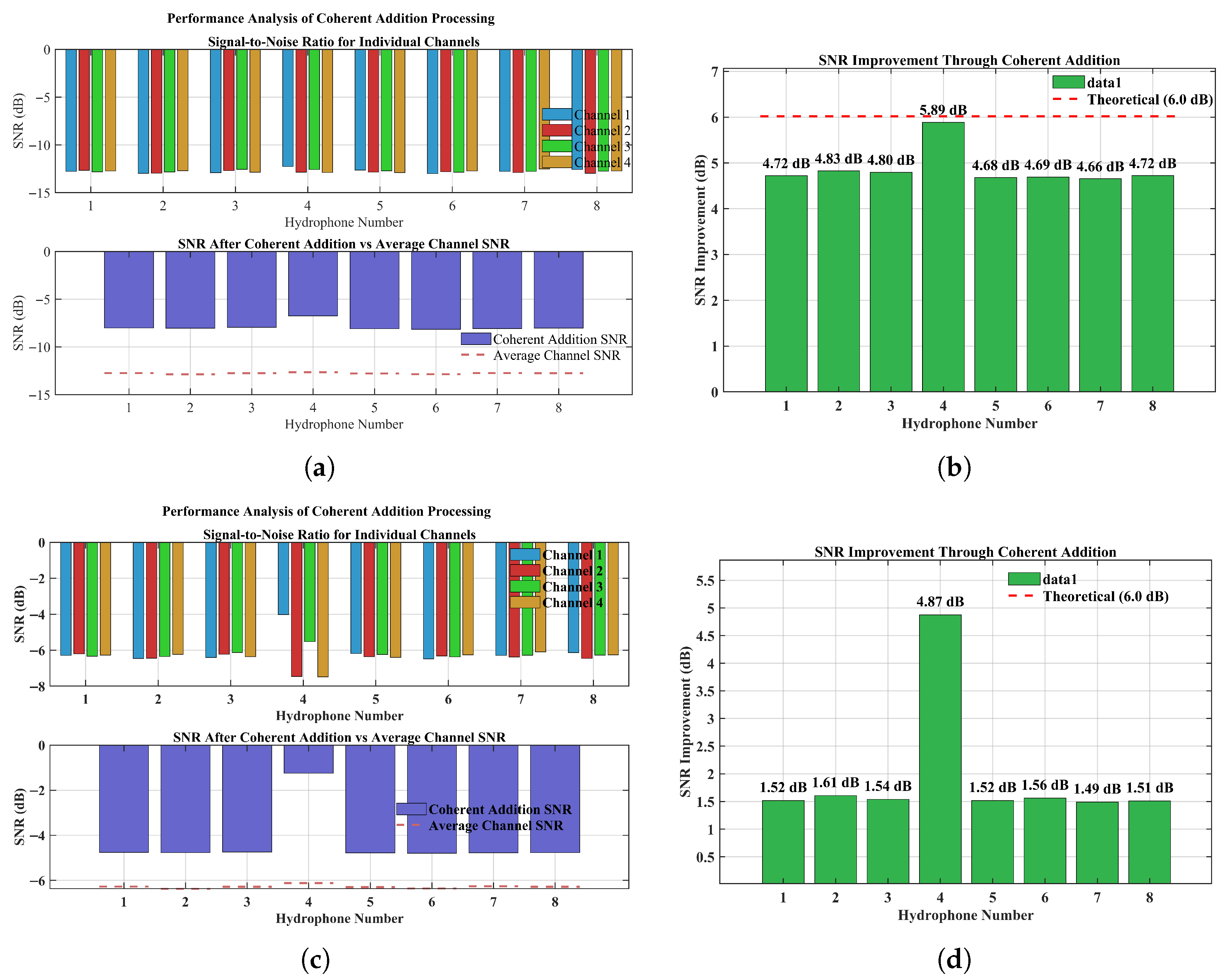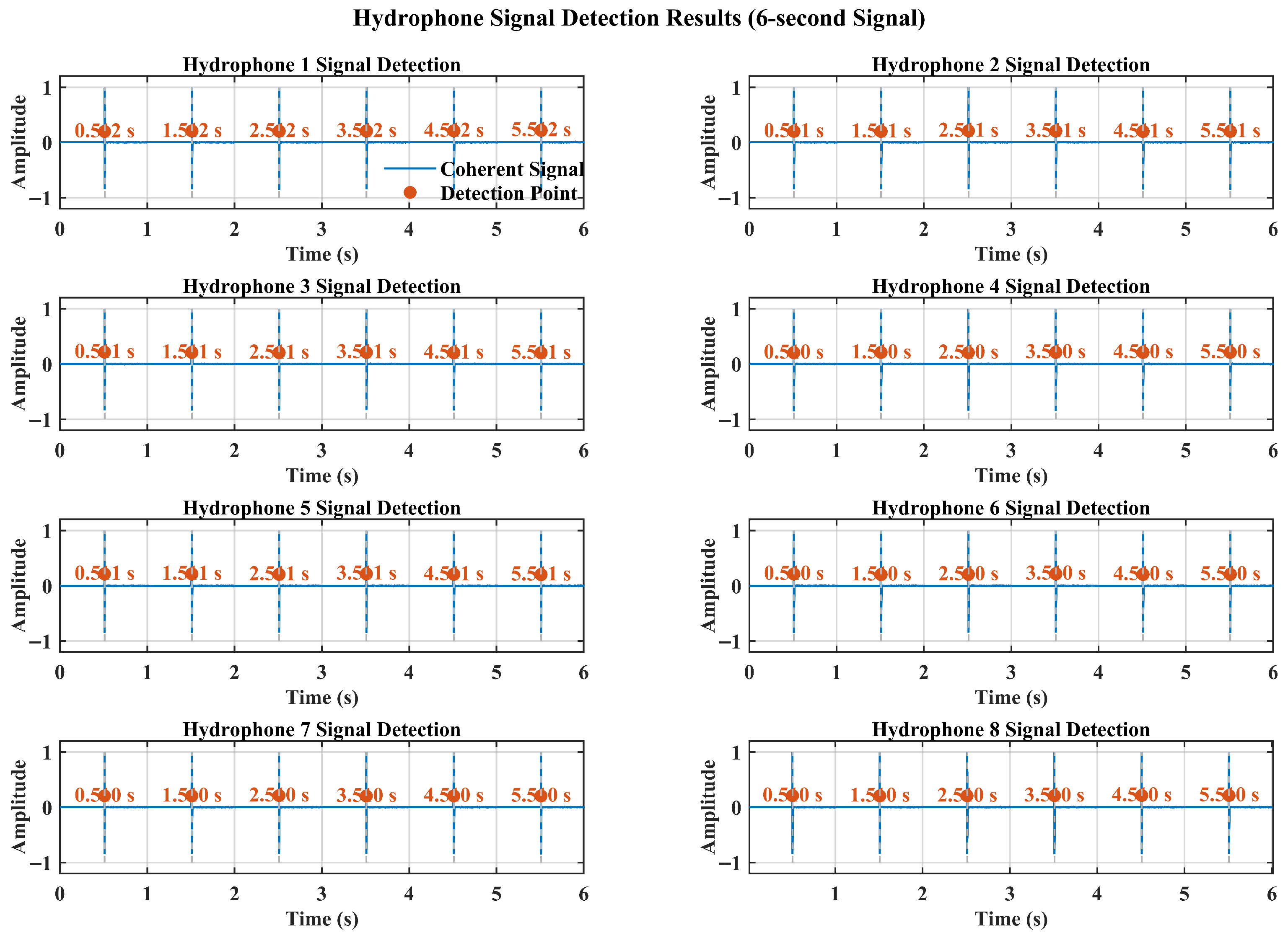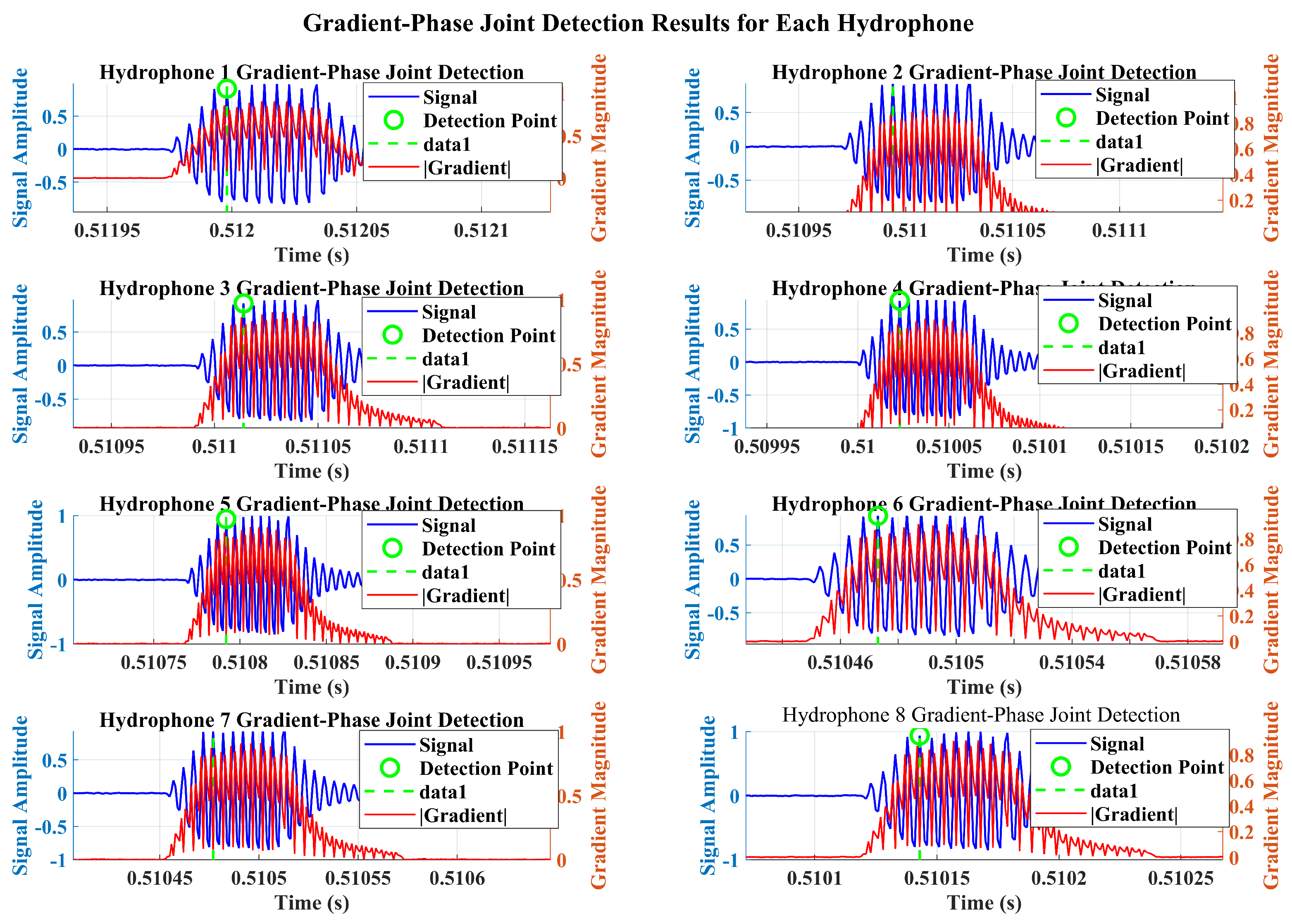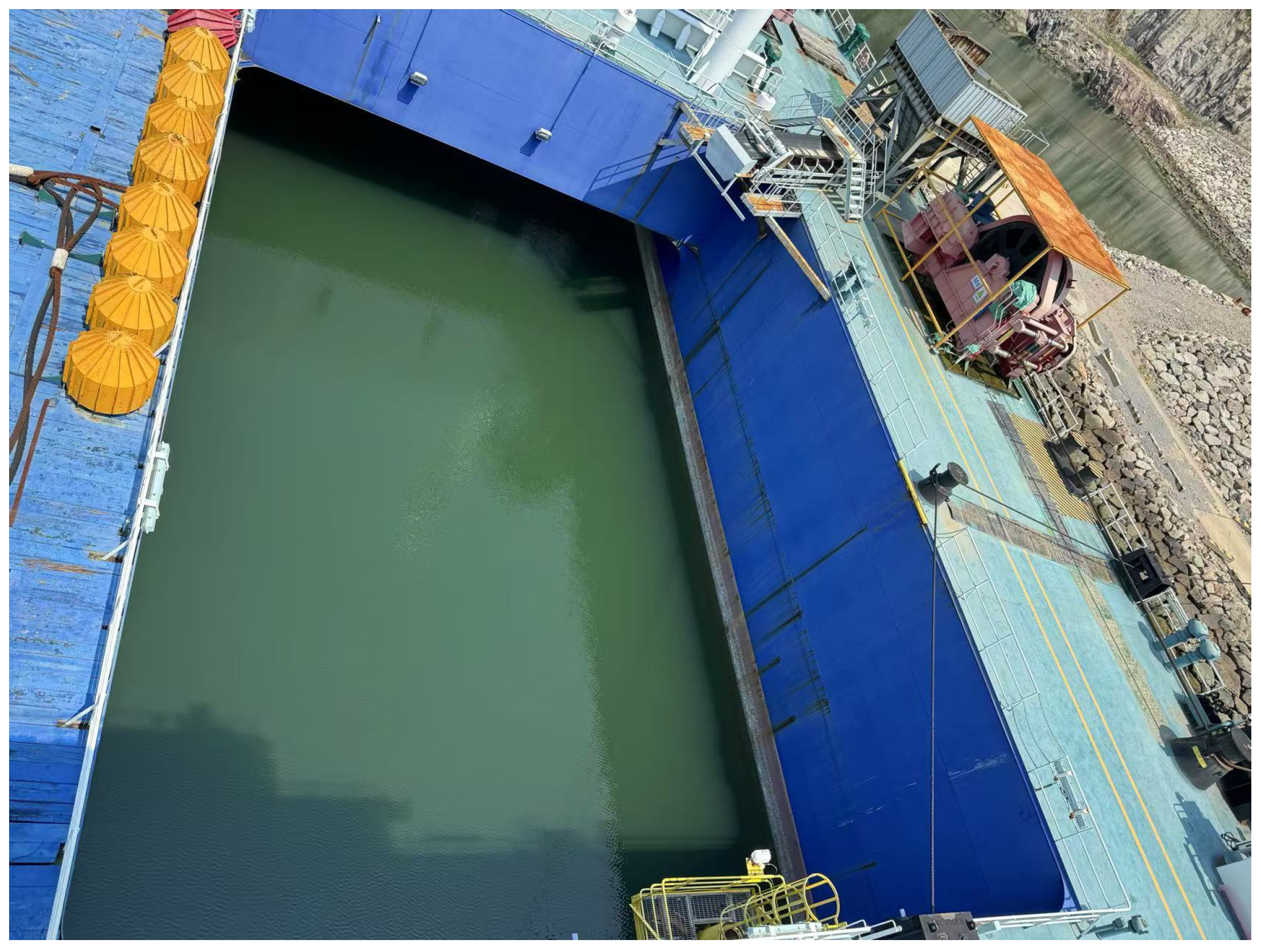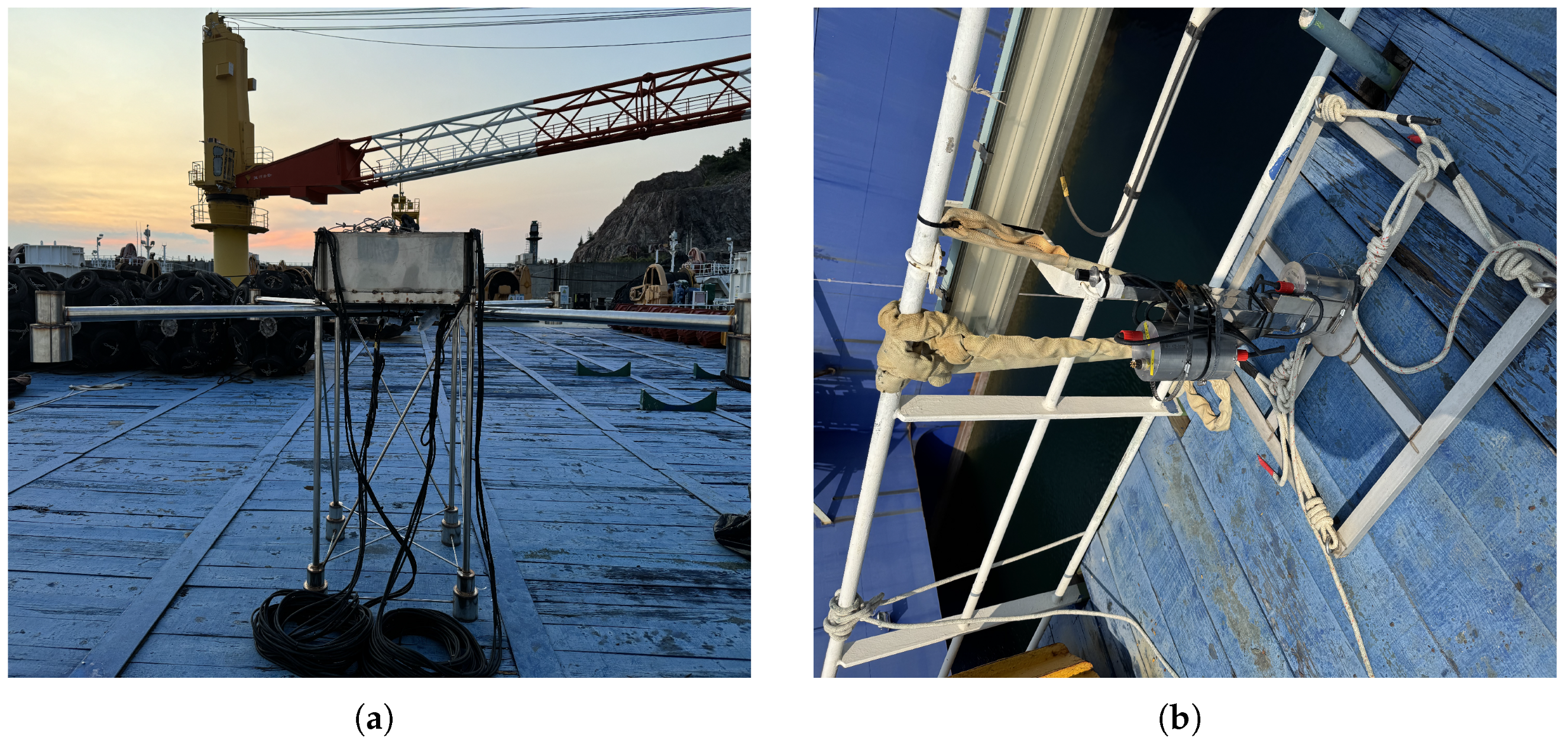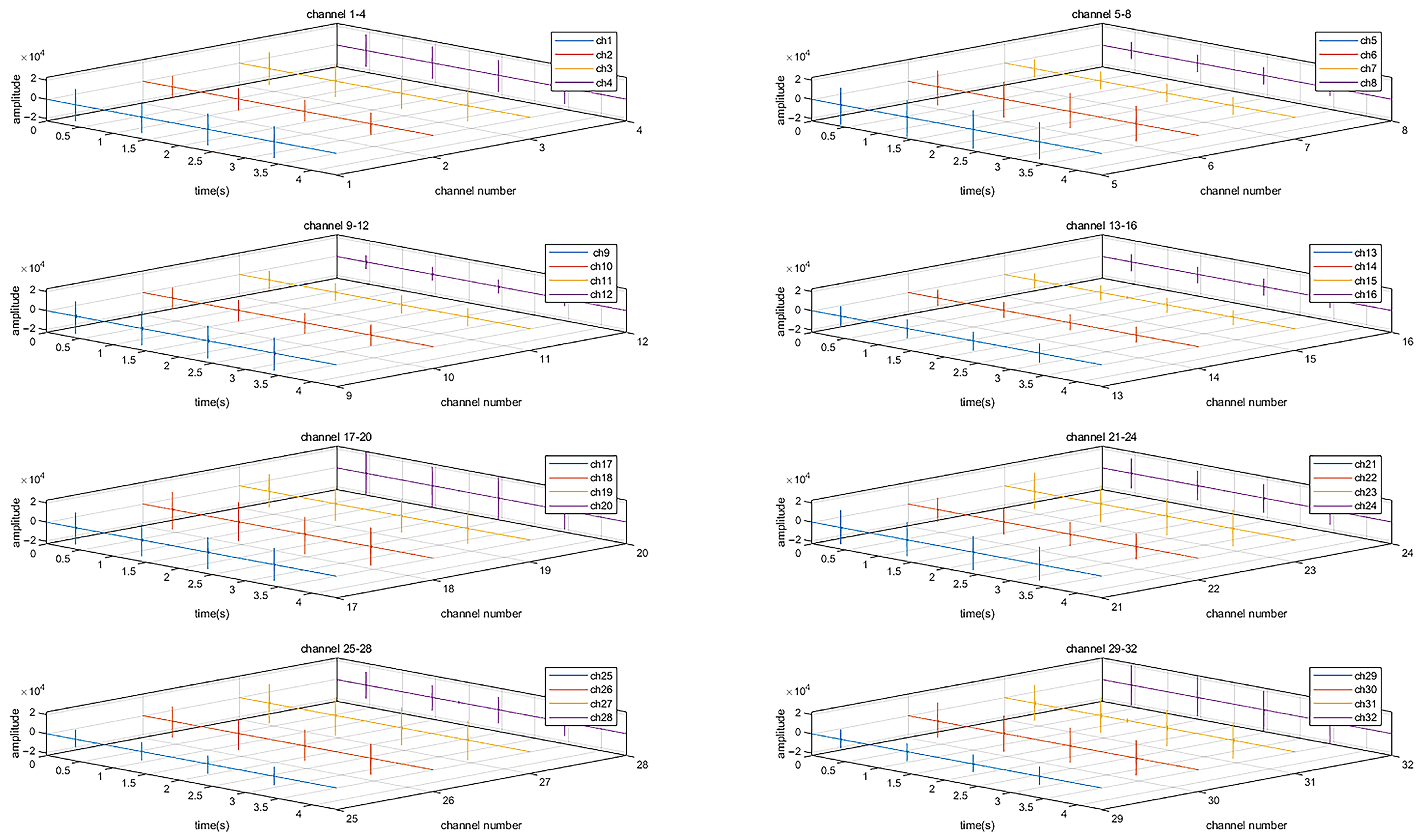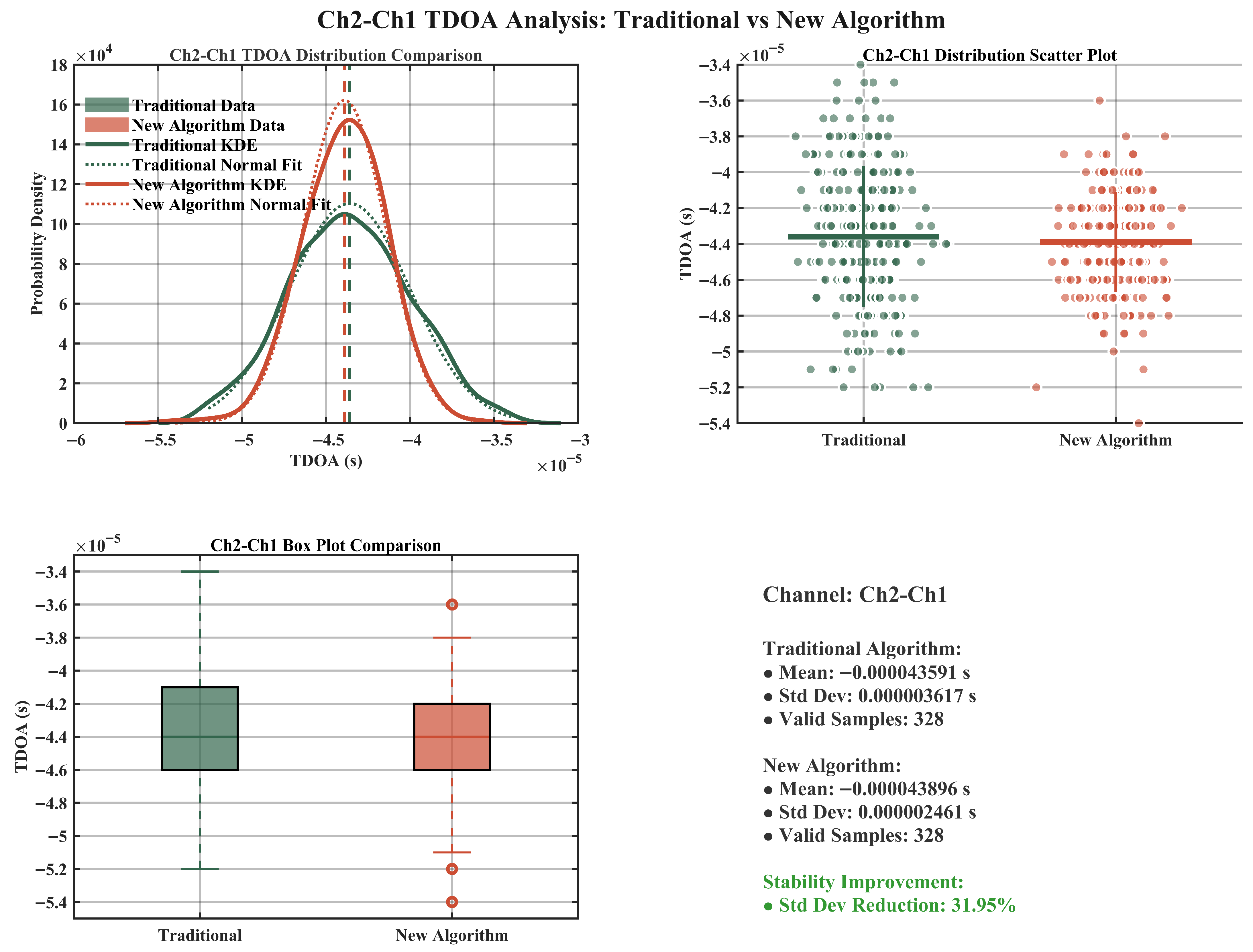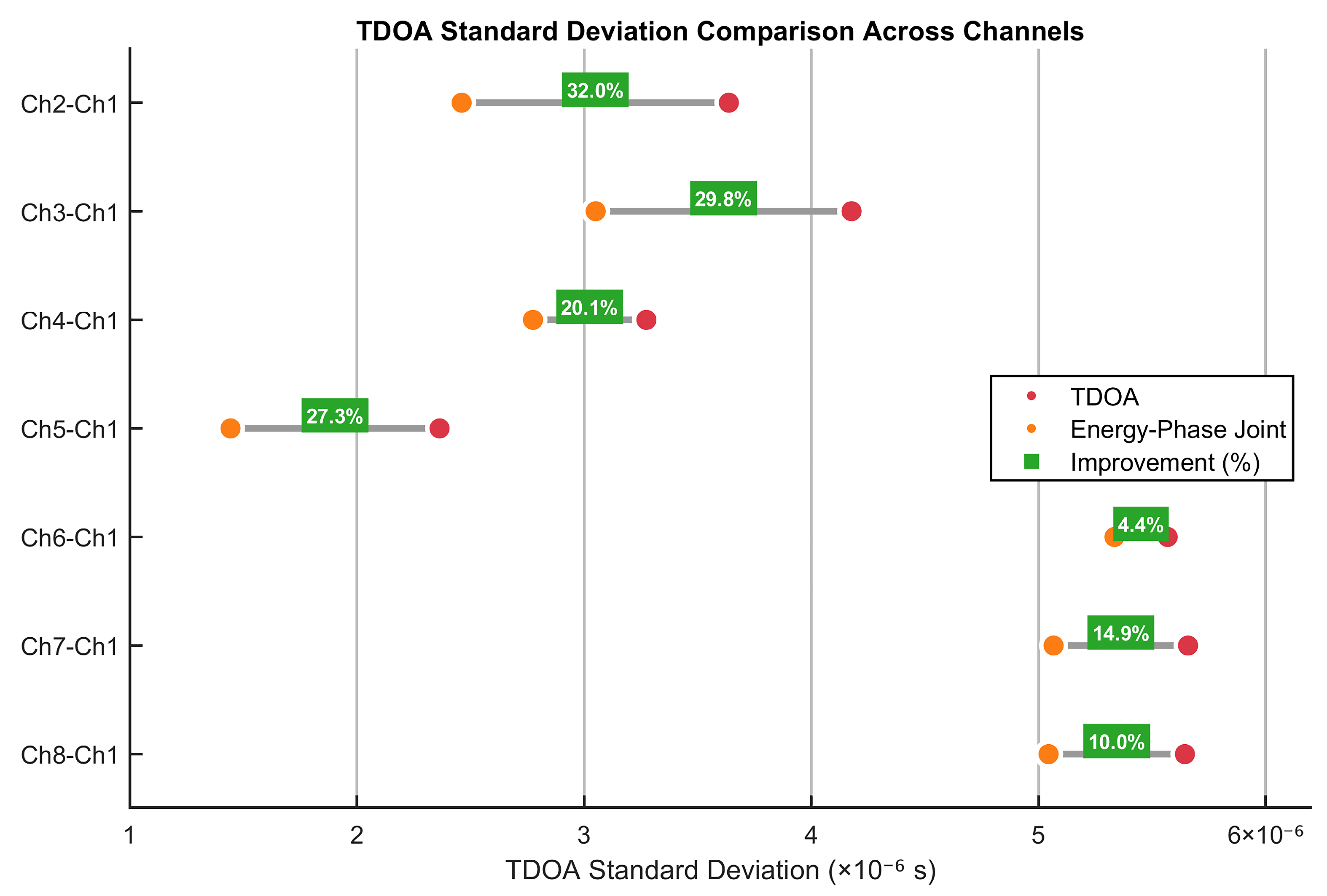To validate the effectiveness of the proposed multi-channel signal fusion methodology and the joint energy-gradient phase detection algorithm, a comprehensive numerical simulation based on the short baseline positioning system is conducted. The simulation focuses on investigating two critical technical aspects:
3.1.1. Simulation Experiment Design
This simulation is based on the construction of a short baseline system of 8 hydrophones, each equipped with 4 receiver channels, forming a 32-channel simultaneous acquisition system. The hydrophone configuration employs a quadruple-channel architecture where four independent receiving elements are uniformly distributed in a circular configuration within each hydrophone. This symmetric four-channel arrangement within each hydrophone unit enhances spatial sampling and provides improved directional sensitivity. The key parameters are set as
Table 2 and
Table 3.
The steps for implementation are as follows:
Step 1: Signal generation and propagation modeling
A template signal featuring a three-phase envelope structure is generated, comprising a rising phase (25 s), a stable phase (35 s), and a decay phase (60 s), with pulse signals transmitted at 1-s intervals to construct a 6-s test sequence.
Step 2: Multi-channel signal reception simulation
Channel-specific propagation delays are computed based on hydrophone array geometry and source bearing, with additive noise and multipath interference incorporated to synthesize realistic 32-channel received signals.
Step 3: Signal Processing and Algorithm Validation
The evaluation encompasses both signal-to-noise ratio enhancement and detection algorithm performance assessment. Initially, the signal-to-noise ratios before and after multi-channel fusion are compared to evaluate the effectiveness of the proposed superposition technique. Subsequently, the fused signals are processed using both conventional cross-correlation methods and the proposed joint energy-gradient phase detection algorithm. Performance comparison focuses on two critical metrics: detection accuracy and algorithmic stability, thereby validating the efficacy and advantages of the developed detection approach. Please refer to Multi-channel Signal Processing Algorithm for the specific algorithm flow.
3.1.2. Simulation Results and Analysis
In this section, simulation experiments are conducted to verify the effect of multi-channel signal superposition and the performance of the joint energy gradient-phase detection algorithm s. Comparative analyses are conducted with the traditional cross-correlation methods, focusing on the algorithm’s performance in the detection of microsecond pulsed signals and the estimation of time delays.
In order to verify the effectiveness of multi-channel cooperative reception, the changes in the signal-to-noise ratio before and after the superposition of the signals of each channel are tested under the conditions of −10 dB and 0 dB ambient noise, respectively, and the results are shown in
Figure 3.
The simulation results demonstrate that the joint energy-gradient phase detection algorithm exhibits robust detection stability and superior accuracy when processing ultra-short pulse signals. Simulation results show that coherent accumulation of multi-channel signals after alignment can significantly improve the signal-to-noise ratio. Under −10 dB harsh noise environment, the SNR improvement reaches 36.06%; under 0 dB better environment, 24.40% improvement can still be obtained.
The detection performance of the proposed joint energy-gradient phase algorithm is evaluated using ultra-short pulse signals, with comprehensive performance metrics and detailed detection outcomes presented in
Figure 4 and
Figure 5, respectively.
The simulation results demonstrate that the joint energy-gradient phase detection algorithm exhibits robust detection stability and superior accuracy when processing ultra-short pulse signals.
To further validate algorithm performance, TDOA calculations are performed using hydrophone 4 as the reference channel, with systematic comparison of detection timing and delay estimation accuracy between the proposed algorithm and conventional cross-correlation methods. Comparative detection performance is summarized in
Table 4.
Analysis of the data presented in
Table 4 reveals that both detection methods achieve successful signal identification in the majority of test cases, albeit with systematic differences in performance characteristics. The joint energy-gradient phase detection algorithm consistently identifies signal arrival times approximately 29
s later than the conventional cross-correlation approach. This temporal offset demonstrates remarkable stability and consistency across measurements, indicating an intrinsic algorithmic difference in signal feature extraction rather than stochastic error propagation. Notably, the cross-correlation method exhibits detection inconsistencies across certain hydrophone channels (highlighted entries in
Table 4), thereby demonstrating the inherent stability limitations of traditional detection methodologies.
To comprehensively evaluate algorithmic performance, TDOA estimation results from both approaches are compared against theoretical reference values, with comparative analysis presented in
Figure 6.
Figure 6a illustrates the TDOA estimation accuracy performance of both detection algorithms across eight hydrophone positions. Experimental analysis demonstrates that the joint energy-gradient phase algorithm (blue circles) and conventional cross-correlation method (orange diamonds) successfully track the theoretical reference values (green squares). However, the proposed energy-gradient phase approach exhibits superior overall tracking precision compared to the traditional methodology. The magnified view of the H1–H3 interval demonstrates that within high-magnitude TDOA regions, the energy-gradient phase algorithm achieves significantly reduced deviation from theoretical values relative to the conventional cross-correlation approach.
Figure 6b provides a detailed analysis of the absolute error at each hydrophone location. The data show that at position H1, the absolute error of the energy gradient-phase method is 0.028 ms, which is 17.6% less compared to 0.034 ms for the mutual correlation method; at position H3, the errors of the two methods are 0.017 ms and 0.024 ms, respectively, with the former 29.2% less compared to the latter. At position H8, the two methods both reach the lowest error level of 0.00009 ms, indicating that the performance of the algorithms converges in this geometric configuration.
The algorithmic differences are further quantified by the statistical analysis of the performance metrics in
Figure 6c. The energy gradient-phase method outperforms the conventional method in four key metrics: the RMSE decreases from 0.0167 ms to 0.0135 ms, the MAE decreases from 0.0125 ms to 0.0096 ms, the standard deviation decreases from 0.012 ms to 0.0102 ms, and the maximum error decreases from 0.0334 ms to 0.0284 ms.
The performance summary in
Figure 6d shows that the combined energy gradient-phase detection method achieves an overall performance improvement over the conventional inter-correlation method: 1.24-fold improvement in RMSE, 1.30-fold improvement in MAE, 1.17-fold improvement in standard deviation, and 1.18-fold improvement in maximum error. Statistical significance testing confirms that these performance improvements are statistically significant (
t = 3.892,
p = 0.015 < 0.05), providing robust evidence for the superiority of the proposed method over conventional approaches. A comprehensive evaluation based on the RMSE improvement multiple shows that the new method achieves an overall performance improvement of 19.1% (formula:
, where
R is the RMSE improvement multiple), which verifies the effectiveness and superiority of the joint energy gradient-phase detection algorithm for the TDOA estimation task.
The simulation experiment results verify the effectiveness of the proposed technical scheme. The multi-channel cooperative reception strategy can significantly improve the signal quality under low SNR conditions, with a SNR gain of 36.06% under the worst environment ( dB), and still 24.40% under the better environment (0 dB). The joint energy gradient-phase detection algorithm shows a significant advantage over the traditional mutual correlation method in terms of delay estimation accuracy, with a comprehensive performance improvement of 19.1%, as well as a significant improvement in detection stability. These results fully demonstrate the technical advantages of the proposed algorithm in microsecond hydroacoustic pulse signal detection.
